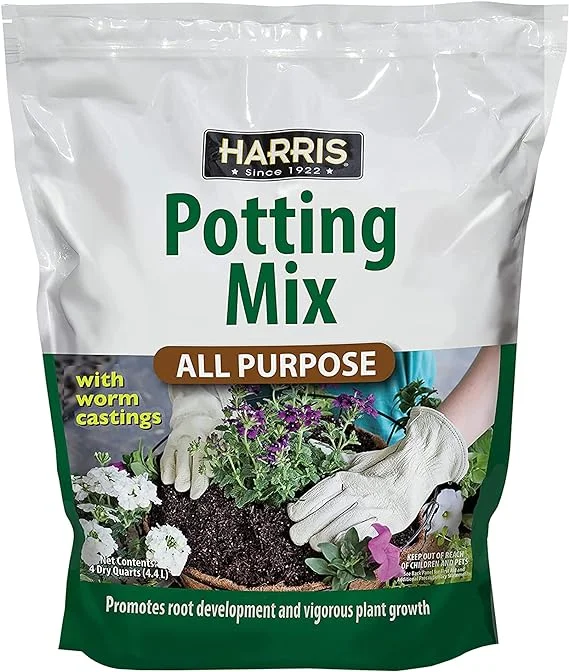Lucky Bamboo (Dracaena sanderiana) Indoor Care, Propagation, Problems & Remedies
Some links in this post may be affiliate links
Dracaena sanderiana (Lucky Bamboo) thrives in bright indirect light, warm and humid conditions and consistently moist, rich, well-drained soil coupled with monthly feeding in spring and summer.
Dracaena sanderiana also called Curly Bamboo, Ribbon Plant, Ribbon Dracaena or Chinese Water Bamboo is among the popular Dracaena varieties due to its tolerance to shade conditions and its ability to grow either in water or in soil.
Ribbon Dracaena is also popular with feng shui enthusiasts as it is believed to bring good luck and hence the common name, 'Lucky Bamboo'. Though called a Bamboo, it is a Dracaena.
Curly Bamboo has highly twisted arching grey-green leaves about 9 inches long. The stems are slender, soft and upright. The roots are red.
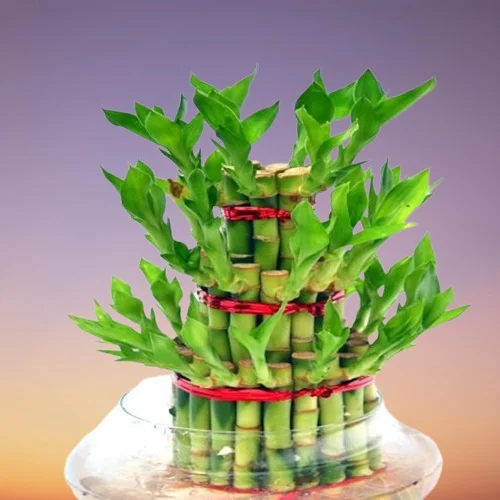
Botanical name: Dracaena sanderiana
Synonym: Phleomele sanderiana
Family: Asparagaceae
Subfamily: Nolinoideae
Common names: Lucky Bamboo, Curly Bamboo, Ribbon Plant, Ribbon Dracaena, Chinese Water Bamboo
Origin
Dracaena sanderiana is native to Central Africa, although it is thought to be from China or Belgium. It is named after a German-English gardener Henry Frederick Conrad Sander (1847-1920).
Size
Ribbon Plant grows to a maximum height of 2-3 feet and the leaves are about 9 inches long. It is one of the best small low light plants for an office desk.
Where to Buy
Chinese Water Bamboo are great plants for any collection. You may acquire them online from Etsy (Link to Etsy) or from Amazon (Link to Amazon).
How to Care for Dracaena sanderiana Indoors
To care for Dracaena sanderiana indoors, provide bright indirect light (dappled light), warmth of 16-270C, humidity of 50-55% and consistently moist, fertile, well-drained potting mix coupled with monthly feeding in spring and summer.
Lucky Bamboo does not need frequent repotting as it grows best when slightly root-bound. Frequent pruning is necessary to keep the plant neat, discourage pests and disease and encourage a bushy growth.
Curly Bamboo can be grown in water or in soil. The light, temperature and humidity requirements are similar in both cases. Keep reading for more on these growing conditions and how to achieve them.
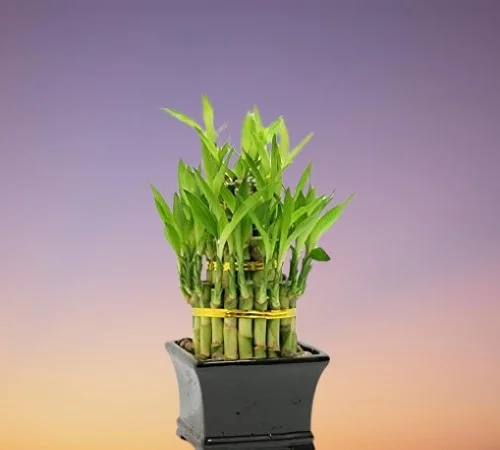
Light Requirements
Does Dracaena sanderiana need sunlight?
No. Dracaena sanderiana grows best in bright indirect light. Too low light will cause the leaves to turn pale-green from grey-green. Keep it away from direct sunlight to prevent scorching of the leaves.
Insufficient light will result in stunted and leggy growth and yellowing of leaves. If the natural lighting is not sufficient, use full spectrum grow lights to supplement it.
Temperature & Humidity
Lucky Bamboo flourishes in a warmth of 16-270C. Keep it away from sources of drafts like windy doors, AC units, heat sources and others as they can cause reduced growth, leaf drop and brown leaf tips and edges.
Dracaena sanderiana prefers a humidity of 50-55%; it has no need for high humidity. However, if the temperatures are very high, the humidity reduces significantly and will result in brown leaf tips. To elevate humidity, set the pot on a wet pebble tray or use a cool mist humidifier.
Do not mist the leaves and maintain free air circulation to minimize fungal diseases. Regularly clean the leaves by damp-wiping to get rid of dust and also discourage pests and diseases infestation.
(A) Dracaena sanderiana Care in Water
- Use an opaque container to prevent the growth of algae in the water as sunlight through a transparent container will promote the growth of algae.
- Fill the container with pebbles to about a third. Set the plant in the center of the container and continue to fill the container and leave about 1-1.5 inches from the top rim unfilled.
- Before the roots develop ensure at least 3 inches of the cane are submerged in water. Once the roots develop ensure that the roots are always covered by water to prevent rotting.
- Change the water every 5-7 days. Use only chlorine-free water like rainwater or filteredwater as the plant is sensitive to chemicals dissolved in water and they may cause the plant to die.
- As the plant grows, increase the water level as the higher the water level goes up the stem, the more the roots will grow. The more the roots, the more lush the foliage will be.
- To enhance growth of the foliage, add a drop of balanced, water-soluble fertilizer everytime you change the water.
- Always ensure that the leaves are out of the water to prevent rotting. Snip off slimy or dark roots; the roots should be red in color. If the roots become mushy, cut the stem just above the roots and start a new plant.
- Clean the container and pebbles with soapy water if they become murky, rinse them very well and refill the container with fresh water.
Pruning & training a Lucky Bambo growing in water
To encourage a bushy and compact Lucky Bamboo that is growing in water, prune it by cutting the offshoots about 1-2 inches from the main stem.
This will encourage the plant to produce new shoots at a point below the cut. The cut shoots can be used to start new plants.
To make the twists and the curves, curl the stems with wire to hold them in place or block the light on three sides of the plant to force it to grow towards the light source.
Keep turning the stem as it grows to make the curves and the twists. This requires constantly checking on the plant and may take a long time get the twisted stems.
Propagating Dracaena sanderiana growing in water
A Lucky Bamboo that is growing in water can be propagated from stem-tip cuttings (shoots).
Propagating Dracaena sanderiana from shoots
- On removing the shoots during pruning, dip the lower cut-end in a rooting hormone to hasten establishment.
- Fill a small pot with well-draining soil and moisten it lightly.
- Insert 2-3 inches of the lower cut-end of the cutting in moist soil or you can water propagate.
- Place the set up in a warm, well-lit place away from direct sunlight to avoid scorching.
- Maintain the soil moist until the new plants are well established after which you can begin routine care.
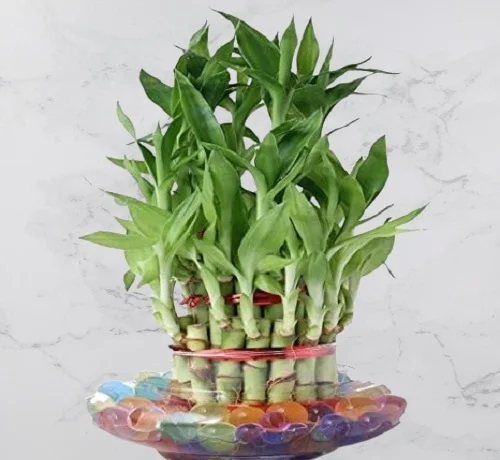
(B) Dracaena sanderiana Care in Soil
When grown in soil, the Lucky Bamboo loses its bamboo-like look and fills with a leaf-like shape like other Dracaenas.
Watering
How often should you water a Dracaena sanderiana?
Water Dracaena sanderiana thoroughly in spring and summer while allowing the top 1-2 inches of soil to dry out between waterings. Maintain the soil consistently moist but not soggy to avoid rotting, yellowing and leaf loss.
Reduce the watering in fall and winter to keep the soil slightly moist since growth is reduced. Do not allow the soil to dry out completely to prevent wilting, yellowing and leaf drop.
Confirm that the pot has a drainage hole and the soil is well-draining to avoid waterlogging which can lead to root-rot and death of the plant
Use water that is at room temperature to avoid shocking this tropical plant as it can lead to reduced growth, yellowing and leaf fall. Ascertain that the water is free of chlorine, flourides and other dissolved chemicals to prevent browning of leaf tips and edges.
Fertilizer
Feed Lucky Bamboo with a balanced, water-soluble fertilizer every 4 weeks in spring and summer for a lush growth.
Withhold feeding in fall and winter to prevent fertilizer burn as growth is minimal at this time.
Flush out accumulated salts regularly by running a stream of water through the soil until the water comes out through the drainage hole.
Repotting
Repot Lucky Bamboo at the beginning of the growing season (spring to early summer) when the roots begin to grow through the drainage holes; the plant prefers to be slightly root-bound.
Select a pot 1 size larger than the current one. Ensure that the pot has a drainage hole and the soil is well-draining to prevent waterlogging; never allow the roots to sit in soggy soil as it can lead to root-rot. Check out these pots with drainage holes on Amazon.
Potting Soil
The best soil for Lucky Bamboo should be rich in organic matter and free-draining to prevent it from getting soggy while providing the required nutrients. A blend of 2 parts organic potting mix and 1 part perlite (for drainage) is great for this plant.
Pruning
Pruning Lucky Bamboo involves removal of dead and yellow leaves to maintain the plant neat and also discourage pests and diseases.
To encourage a bushy and compact growth, cutback the stems. New stems will sprout below the cut. The foliage emanating from the pruning, can be used to propagate new plants.
Propagating Dracaena sanderiana growing in soil
Lucky Bamboo that is growing in soil is propagated from stem cuttings or from the crown of leaves of leggy plants at beginning of the growing season when in active growth for faster establishment.
Propagating Dracaena sanderiana from stem cuttings
- Take 4-6 inches long stem cuttings from a healthy plant.
- Dip the lower cut-end of the cutting in a rooting hormone to hasten rooting.
- Fill a small pot with well-draining soil and moisten it slightly.
- Insert 2-3 inches of the lower cut-end of the cutting in the moist soil and lightly firm the soil around the base of the cutting.
- Cover the set up with clear polythene sheet to create a greenhouse effect for faster establishment.
- Position the set up in a warm, well-lit place away from direct sunlight to avoid scorching.
- Keep the soil moist until the cuttings are rooted.
- Gradually over a period of 2 weeks remove the polythene cover to acclimate the new plant to ordinary growing conditions.
- When the new plant is well established, transplant it into a pot one size larger in well-draining soil after which you can begin routine care.
Propagating Dracaena sanderiana from the top crown of leaves
- Cut the top crown of leaves bearing about 3 inches of stem.
- Dip the stem of the crown of leaves in a rooting hormone to hasten rooting.
- Fill a small pot with free-draining soil and moisten it lightly.
- Insert the stem of the cutting in the moist soil and slightly firm the soil around the stem.
- Place the set up in a warm, brightly-lit place away from direct sunlight to avoid scorching.
- Maintain the soil moist until the cuttings are rooted which is indicated by new growth.
- Once the new plants are well established, you can begin routine care.
Learn how to propagate Dracaena Plants by 4 propagation methods.
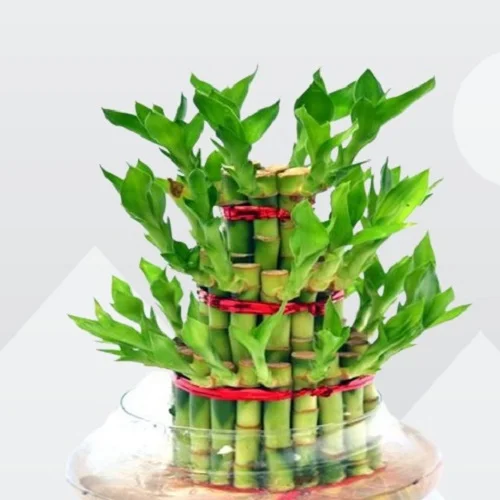
Dracaena sanderiana Problems & Solutions
Lucky Bamboo (Dracaena sanderiana) problems are yellowing leaves, brown leaf tips & edges, leaf drop, plant dying, pests and diseases among others. Keep reading for more on these problems and how to fix them.
Yellowing leaves
Yellowing leaves on Dracaena sanderiana is caused by too little light, soggy soil, inconsistent watering, drafts, nutrients deficiency or aging.
How to fix it
Too little light: Position the plant in bright indirect light or use a grow light if you do not have enough light in your home.
Soggy soil: Use well-draining soil and a pot with a drainage hole.
Inconsistent watering: Water when the top 1-2 inches of soil feel dry to the touch but do not allow the soil to dry out completely.
Drafts: Keep the plant away from sources of drafts like hot air vents, AC units, hot surfaces, windy doors among others.
Nutrients deficiency: Feed the plant with a balanced, water-soluble fertilizer every 4 weeks in spring and summer.
Aging: This is a natural process. As the plant matures it sheds the lower leaves. Each lower leaf turns yellow and dries leaving a crown of leaves on top of the cane-like stem.
Check out these 14 Reasons why Dracaena Leaves are Yellowing and their Remedies
Brown leaf tips & edges
Brown leaf tips and edges on Lucky Bamboo are caused by dry air, underwatering, salts buildup or cold drafts.
How to fix it
Dry air: Set the pot on a wet pebble tray, group the plants together or use a cool mist humidifier to raise humidity. You may also grow the plant in a well-lit bathroom, kitchen, laundry area and other humid areas in the home.
Underwatering: Water when the top 1-2 inches of soil dry out but do not allow the soil to dry out completely.
Salts buildup: Use chemical free water for watering the plant and regularly flush out excess salts from the soil.
Cold drafts: Keep the plant away from cold drafts coming from drafty windows, windy doors, AC units among others.
Leaf drop
Leaf drop on Lucky Bamboo is caused by inconsistent watering, soggy soil, drafts, use of cold water or low humidity.
How to fix it
Inconsistent watering: Water when the top 1-2 inches dry out. Do not water on a schedule.
Soggy soil: Use a pot with a drainage hole and well-draining soil.
Drafts: Keep the plant away from sources of drafts like AC units, heat sources, stoves, windy doors and windows among others.
Use of cold water: Use water that is at room temperature to avoid cold shock.
Low humidity: Group the plants together, use a cool mist humidifier or set the pot on a wet pebble tray to upscale humidity.
Plant dying
Dracaena sanderiana may be dying due to cold drafts, salts buildup, soggy soil or root-rot disease.
How to fix it
Cold drafts: Keep the plant away from sources of cold drafts like AC units, windy doors and windows among others to maintain a warmth of 16-270C.
Salts buildup: Once in a while flush out accumulated salts by running a stream of water through the soil until the water comes out through the drainage hole.
Soggy soil: Make sure that the pot has a drainage hole and that the soil is well-draining.
Root-rot disease which is prevalent in soggy soil. It is characterized by wlting, yellowing and browning of the leaves which is rapidly followed by plant collapse.
How to fix it
- Carefully, slip the plant out of its pot and inspect the roots. Brown mushy roots indicate root-rot.
- Cut the brown-black roots and treat the healthy roots with a copper-based fungicidal solution as recommended by the manufacturer.
- Repot the plant in fresh, well-draining soil and keep it dry for some time before resuming watering.
- Use a pot with a drainage hole to prevent the soil from getting soggy.
- Cut down on watering in fall and winter as growth is minimal at this time, therefore, the plant does not need much water.
Pests
Common pests on Lucky Bamboo are mealybugs, scales and spider mites which are common in stuffy, dry conditions.
How to fix it
- Isolate the affected plant to prevent spread to other plants.
- Treat the plant with an insecticidal soap or neem oil as per the manufacturer's recommendations.
- Regularly check underneath and between the leaves for these pests and carry out timely control measures.
- Maintain the plant well pruned and raise humidity to discourage the pest infestations.
You liked it? Share on social media.
Related Content
Amazon Associates Disclosure
Homeplantsguide.com is a participant in the Amazon Services LLC Associates Program, an affiliate advertising program designed to provide a means for sites to earn advertising fees by advertising and linking to amazon.com.
